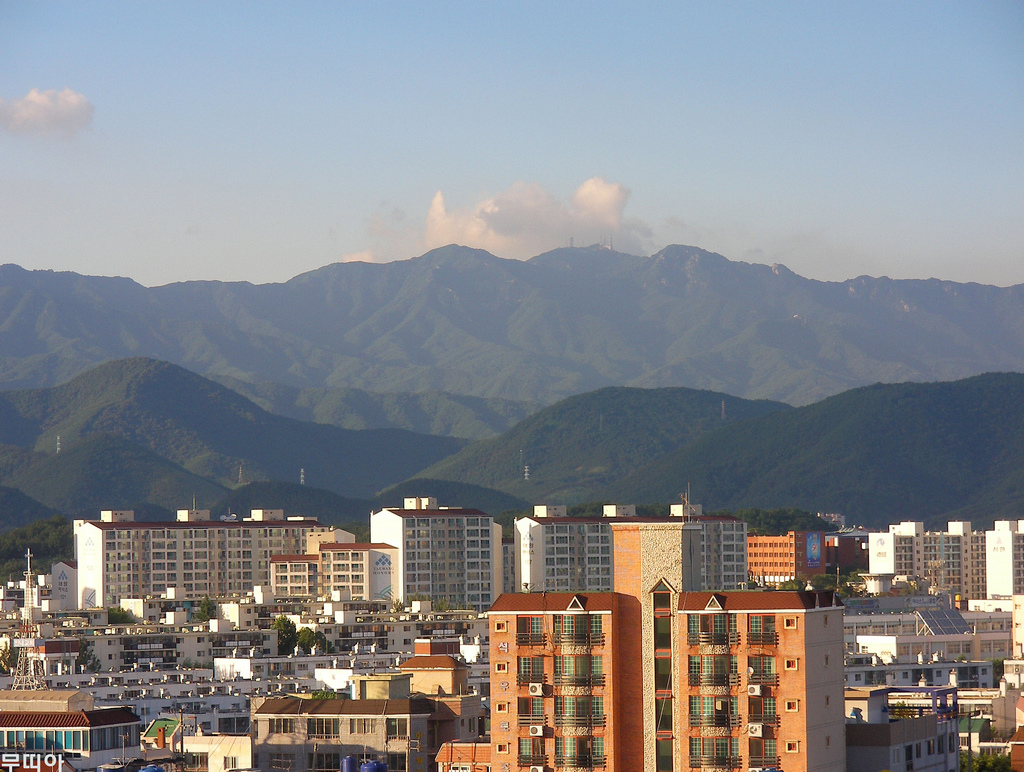Palgongsan on:
[Wikipedia]
[Google]
[Amazon]

 Palgongsan, also Palgong Mountain, and previously called Gongsan during the
Palgongsan, also Palgong Mountain, and previously called Gongsan during the

 Palgongsan, also Palgong Mountain, and previously called Gongsan during the
Palgongsan, also Palgong Mountain, and previously called Gongsan during the Goryeo dynasty
Goryeo (; ) was a Korean kingdom founded in 918, during a time of national division called the Later Three Kingdoms period, that unified and ruled the Korean Peninsula until 1392. Goryeo achieved what has been called a "true national unificat ...
, is a mountain in southeastern South Korea
South Korea, officially the Republic of Korea (ROK), is a country in East Asia, constituting the southern part of the Korea, Korean Peninsula and sharing a Korean Demilitarized Zone, land border with North Korea. Its western border is formed ...
, lying on an outlier of the Taebaek range. It stands on the northeastern border between Daegu
Daegu (, , literally 'large hill', ŽĆÄÍĶ¨ÍīĎžó≠žčú), formerly spelled Taegu and officially known as the Daegu Metropolitan City, is a city in South Korea.
It is the third-largest urban agglomeration in South Korea after Seoul and Busan; it is ...
metropolitan city and North Gyeongsang
North Gyeongsang Province ( ko, Í≤ĹžÉĀŽ∂ĀŽŹĄ, translit=Gyeongsangbuk-do, ) is a province in eastern South Korea. The province was formed in 1896 from the northern half of the former Gyeongsang province, and remained a province of Korea until t ...
province (including the districts of Chilgok County, Gunwi County, Yeongcheon, and Gyeongsan
Gyeongsan () is a city in North Gyeongsang Province, South Korea. Its western border abuts the metropolitan city of Daegu, and much of Gyeongsan lies within the Daegu metropolitan area.
Numerous universities are located in Gyeongsan, such as Ye ...
). Its peak is 1193 m above sea level
Mean sea level (MSL, often shortened to sea level) is an average surface level of one or more among Earth's coastal bodies of water from which heights such as elevation may be measured. The global MSL is a type of vertical datuma standardis ...
.
The mountain is the site of a number of cultural and natural heritage sites. These include Buddhist shrines from the Silla
Silla or Shilla (57 BCE ‚Äď 935 CE) ( , Old Korean: Syera, Old Japanese: Siraki2) was a Korean kingdom located on the southern and central parts of the Korean Peninsula. Silla, along with Baekje and Goguryeo, formed the Three Kingdoms o ...
period or later, including the large and active temple of Donghwasa and the Gunwi Triad Budda Grotto (National Treasure 109). In addition, in 927 the Battle of Gong Mountain
A battle is an occurrence of combat in warfare between opposing military units of any number or size. A war usually consists of multiple battles. In general, a battle is a military engagement that is well defined in duration, area, and force ...
was fought between Hubaekje
Hubaekje or Later Baekje (, ) was one of the Later Three Kingdoms of Korea, along with Taebong and Silla. Later Baekje was a Korean dynastic kingdom founded by the disaffected Silla general Gyeon Hwon in 900, whom led the local gentry and p ...
and Goryeo
Goryeo (; ) was a Korean kingdom founded in 918, during a time of national division called the Later Three Kingdoms period, that unified and ruled the Korean Peninsula until 1392. Goryeo achieved what has been called a "true national unificat ...
forces on the mountain's southern slope.
Natural treasures include the standing stone of Gatbawi
Gatbawi or Stone Seated Medicine Buddha at Gwan Peak, Mt. Palgong in Gyeongsan is a Buddhist statue in Daehan-ri, Wachon-myeon, Gyeongsan, Gyeongsangbuk-do, the Republic of Korea. It was made in the Unified Silla Kingdom era and is well known w ...
, so called from its resemblance to a traditional Korean horsehair hat, or '' gat''.
The mountain, connected to downtown Daegu by bus, is a popular site for weekend outings from the city. Portions of the mountain were designated a provincial park
Ischigualasto Provincial Park
A provincial park (or territorial park) is a park administered by one of the provinces of a country, as opposed to a national park. They are similar to state parks in other countries. They are typically open to t ...
in 1980.
Trail
* Palgongsan Olleh-gil: This trail follows the apple orchards filled with Pyeonggwang Apples at the foot of Mount Palgong. The trail takes about three hours to hike in total. This route starts from the Hyoja tree Gangsunhang at the entrance of Pyeonggwang-dong, and hike through the small reservoir of Pyeonggwangji finally arriving at the Moyeongjae, which is a house where the stone monument of General Shin Sung-gyeom stands. The time to visit this trail is in the spring (April‚ÄďMay) when visitors can see the apple blossoms, and in the fall when the apples are ready to be picked. As follow the apple orchards along the valleys, visitors will find Cheombaekdang, which is a house built for the spirit of hyoja (devoted son) Woo Hyo-jung and seonbi (scholar) Woo Myeong-sik.Course: Pyeonggwang-dong entrance - Pyeonggwang Elementary School - Pyeonggwangji - Moyeongjae - Jaebau farm - Cheombaekdang - Pyeonggwang station (Round-trip 4.6 miles, 2 hours 30 minutes. Level: Easy)
See also
*List of mountains in Korea
The following is a list of mountains in Korea:
List of mountains in North Korea Pyeongyang
* Taesongsan (ŽĆÄžĄĪžāį; ) ‚Äď
Chagang Province
* Namsan (Žā®žāį; ) ‚Äď
* Obongsan (žė§ŽīČžāį; ) ‚Äď
North Pyongan Province
* Myohyangsan (Ž¨ėŪ ...
References